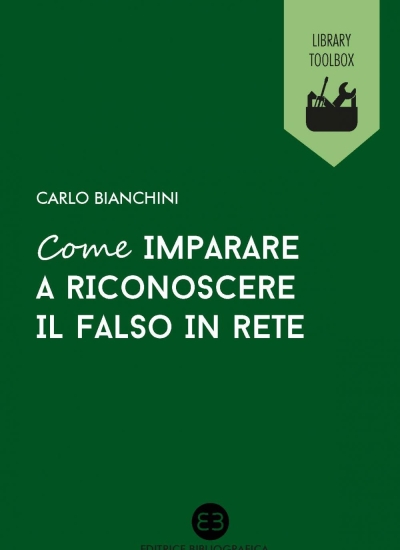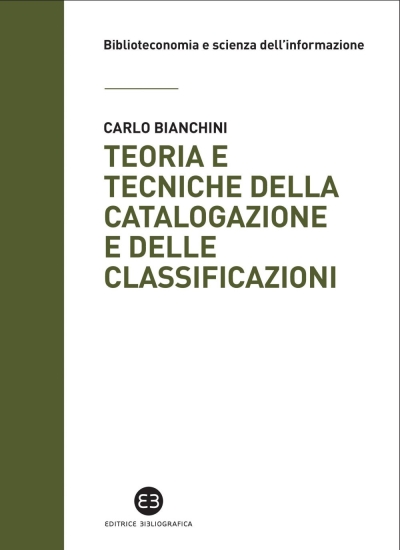Editoriale – Il ruolo dei modelli virtuali 3D nella conservazione del patrimonio architettonico e archeologico | Editorial - The role of virtual 3D models in the conservation of architectural and archaeological heritage
Published in Disegnare idee immagini 53/2016. Rivista semestrale del Dipartimento di Storia, Disegno e Restauro dell’Architettura “Sapienza” Università di Roma | Biannual Magazine of the Department of History, Drawing and Restoration of Architecture
Autor:
Verlag:
Jahr :
2017
ISBN:
9788849296853
DRM:
Adobe (Die heruntergeladene Datei hat die Erweiterung .acsm und wird bei der Installation auf Ihrem eReader in das gekaufte Format konvertiert)
Autor:
Verlag:
Jahr :
2017
ISBN:
9788849296853
DRM:
Adobe (Die heruntergeladene Datei hat die Erweiterung .acsm und wird bei der Installation auf Ihrem eReader in das gekaufte Format konvertiert)
Beschreibung
Nell’ultimo ventennio i professionisti che operano nel rilevamento mediante l’uso di laser scanner e della fotomodellazione hanno dovuto sempre più spesso elaborare dei modelli virtuali 3D non potendo operare direttamente sulla nuvola di punti, ma dovendola fare oggetto di trasformazioni. Infatti tali modelli, dopo essere stati acquisiti, dovevano essere rielaborati al fine di evitare un errore di carattere concettuale commesso da alcuni rilevatori poco accorti o da imprese volte a massimizzare il profitto, i quali utilizzavano la nuvola di punti orientata per ricavarne direttamente le rappresentazioni bidimensionali quali piante, prospetti e sezioni. Questa scorciatoia faceva però sì che alcuni punti caratterizzanti l’opera non fossero presenti fra quelli, numerosissimi, acquisiti; si pensi ad esempio a punti appartenenti a spigoli o all’intersezione di più rette. Pertanto molti rilevatori, tra i quali anche chi scrive, sono stati costretti a rielaborare le proprie nuvole di punti, in quanto esse altro non erano che un insieme di moltissimi punti e dunque si presentavano come un modello numerico; le opere architettoniche o archeologiche sono invece definite da molteplici superfici di varia natura e pertanto sono assimilabili a modelli di tipo geometrico o matematico che dire si voglia. | In the last twenty years any professional who used a laser scanner and photomodelling to perform a survey was increasingly forced to elaborate virtual 3D models. Since it was impossible to work directly on a points cloud the latter had to be transformed. In fact, after acquisition these models had to be re-elaborated to avoid the conceptual mistake made either by less meticulous surveyors or by companies looking for maximum gain, i.e., companies using the oriented points cloud to quickly obtain 2D representations such as plans, elevations and sections. This shortcut, however, meant that some of the characteristic points of the object were not present amongst the countless points that were acquired. Think, for example, of the points of corners or the intersection between straight lines. As a result, many surveyors, including us, were forced to re-elaborate their points clouds because they were nothing but a set of countless points that appeared as a numerical model. Instead architectural or archaeological objects have different kinds of multiple surfaces and are therefore similar to either geometric or mathematical models.
Tags
Tags:
Tags:
Vom selben Autor
DISEGNARE IDEE IMMAGINI N° 50 / 2015
Rivista semestrale del Dipartimento di Storia, Disegno e Restauro dell'Architettura Sapienza Università di Roma
Rivista semestrale del Dipartimento di Storia, Disegno e Restauro dell'Architettura Sapienza Università di Roma
14.99 €
39
-41
 DISEGNARE IDEE IMMAGINI N° 50 / 2015
Rivista semestrale del Dipartimento di Storia, Disegno e Restauro dell'Architettura Sapienza Università di Roma
DISEGNARE IDEE IMMAGINI N° 50 / 2015
Rivista semestrale del Dipartimento di Storia, Disegno e Restauro dell'Architettura Sapienza Università di Roma
Mario Docci, Gangemi Editore
 DISEGNARE IDEE IMMAGINI N° 50 / 2015
Rivista semestrale del Dipartimento di Storia, Disegno e Restauro dell'Architettura Sapienza Università di Roma
DISEGNARE IDEE IMMAGINI N° 50 / 2015
Rivista semestrale del Dipartimento di Storia, Disegno e Restauro dell'Architettura Sapienza Università di RomaMario Docci, Gangemi Editore
14,99 €
DISEGNARE IDEE IMMAGINI N° 45 / 2012
Rivista semestrale del Dipartimento di Storia , Disegno e Restauro dell'Architettura "Sapienza" Università di Roma
Rivista semestrale del Dipartimento di Storia , Disegno e Restauro dell'Architettura "Sapienza" Università di Roma
14.99 €
39
-41
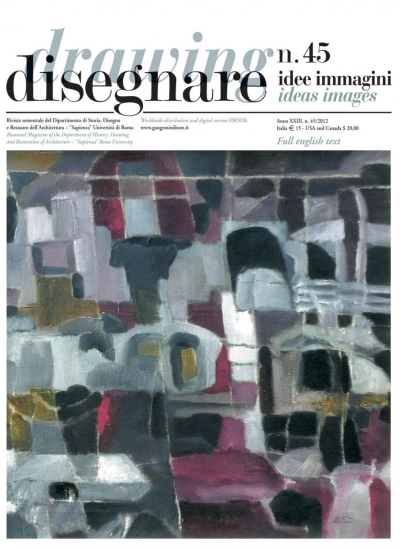 DISEGNARE IDEE IMMAGINI N° 45 / 2012
Rivista semestrale del Dipartimento di Storia , Disegno e Restauro dell'Architettura "Sapienza" Università di Roma
DISEGNARE IDEE IMMAGINI N° 45 / 2012
Rivista semestrale del Dipartimento di Storia , Disegno e Restauro dell'Architettura "Sapienza" Università di Roma
AA. VV., Gangemi Editore
 DISEGNARE IDEE IMMAGINI N° 45 / 2012
Rivista semestrale del Dipartimento di Storia , Disegno e Restauro dell'Architettura "Sapienza" Università di Roma
DISEGNARE IDEE IMMAGINI N° 45 / 2012
Rivista semestrale del Dipartimento di Storia , Disegno e Restauro dell'Architettura "Sapienza" Università di RomaAA. VV., Gangemi Editore
14,99 €
DISEGNARE IDEE IMMAGINI N° 49 / 2014
Rivista semestrale del Dipartimento di Storia, Disegno e Restauro dell'Architettura Sapienza Università di Roma
Rivista semestrale del Dipartimento di Storia, Disegno e Restauro dell'Architettura Sapienza Università di Roma
29.99 €
39
-41
 DISEGNARE IDEE IMMAGINI N° 49 / 2014
Rivista semestrale del Dipartimento di Storia, Disegno e Restauro dell'Architettura Sapienza Università di Roma
DISEGNARE IDEE IMMAGINI N° 49 / 2014
Rivista semestrale del Dipartimento di Storia, Disegno e Restauro dell'Architettura Sapienza Università di Roma
Mario Docci, Gangemi Editore
 DISEGNARE IDEE IMMAGINI N° 49 / 2014
Rivista semestrale del Dipartimento di Storia, Disegno e Restauro dell'Architettura Sapienza Università di Roma
DISEGNARE IDEE IMMAGINI N° 49 / 2014
Rivista semestrale del Dipartimento di Storia, Disegno e Restauro dell'Architettura Sapienza Università di RomaMario Docci, Gangemi Editore
29,99 €
EDITORIALE – UN DISEGNO SU UN FOGLIO LUNGO VENTICINQUE ANNI | EDITORIAL - A DRAWING ON A PIECE OF PAPER TWENTY-FIVE YEARS LONG
Published in Disegnare idee immagini 52/2016. Rivista semestrale del Dipartimento di Storia, Disegno e Restauro dell’Architettura “Sapienza” Università di Roma | Biannual Magazine of the Department of History, Drawing and Restoration of Architecture
Published in Disegnare idee immagini 52/2016. Rivista semestrale del Dipartimento di Storia, Disegno e Restauro dell’Architettura “Sapienza” Università di Roma | Biannual Magazine of the Department of History, Drawing and Restoration of Architecture
4.99 €
39
-41
 EDITORIALE – UN DISEGNO SU UN FOGLIO LUNGO VENTICINQUE ANNI | EDITORIAL - A DRAWING ON A PIECE OF PAPER TWENTY-FIVE YEARS LONG
Published in Disegnare idee immagini 52/2016. Rivista semestrale del Dipartimento di Storia, Disegno e Restauro dell’Architettura “Sapienza” Università di Roma | Biannual Magazine of the Department of History, Drawing and Restoration of Architecture
EDITORIALE – UN DISEGNO SU UN FOGLIO LUNGO VENTICINQUE ANNI | EDITORIAL - A DRAWING ON A PIECE OF PAPER TWENTY-FIVE YEARS LONG
Published in Disegnare idee immagini 52/2016. Rivista semestrale del Dipartimento di Storia, Disegno e Restauro dell’Architettura “Sapienza” Università di Roma | Biannual Magazine of the Department of History, Drawing and Restoration of Architecture
Mario Docci, Gangemi Editore
 EDITORIALE – UN DISEGNO SU UN FOGLIO LUNGO VENTICINQUE ANNI | EDITORIAL - A DRAWING ON A PIECE OF PAPER TWENTY-FIVE YEARS LONG
Published in Disegnare idee immagini 52/2016. Rivista semestrale del Dipartimento di Storia, Disegno e Restauro dell’Architettura “Sapienza” Università di Roma | Biannual Magazine of the Department of History, Drawing and Restoration of Architecture
EDITORIALE – UN DISEGNO SU UN FOGLIO LUNGO VENTICINQUE ANNI | EDITORIAL - A DRAWING ON A PIECE OF PAPER TWENTY-FIVE YEARS LONG
Published in Disegnare idee immagini 52/2016. Rivista semestrale del Dipartimento di Storia, Disegno e Restauro dell’Architettura “Sapienza” Università di Roma | Biannual Magazine of the Department of History, Drawing and Restoration of ArchitectureMario Docci, Gangemi Editore
4,99 €
METODI E TECNICHE INTEGRATE DI RILEVAMENTO PER LA REALIZZAZIONE DI MODELLI VIRTUALI DELL'ARCHITETTURA DELLA CITTÀ
Ricerca COFIN 2004. Coordinatore nazionale Mario Docci
Ricerca COFIN 2004. Coordinatore nazionale Mario Docci
Emanuela Chiavoni,
Priscilla Paolini,
Luigi Affuso,
Piero Albisinni,
Claudio Alessandri,
Barbara Aterini,
Adriana Baculo,
Marcello Balzani,
Maria Teresa Bartoli,
Antonello Bello,
Carlo Bianchini,
Lorenza Bologna,
Lucia Bonanno,
Fausto Brevi,
Massimiliano Campi,
Emanuela Chiavoni,
Michela Cigola,
Roberto Corazzi,
Carmela Crescenzi,
Laura De Carlo,
Mariella Dell'Aquila,
Antonella di Luggo,
Mario Docci,
Riccardo Florio,
Elena Fossi,
Marco Gaiani,
Gabriele Guidi,
Laura Inzerillo,
Michele Inzerillo,
Alfonso Ippolito,
Marco Jaff,
Fabio Lanfranchi,
Emma Mandelli,
Lorenzo Martella,
Sara Mattei,
Giampiero Mele,
Carlo Mezzetti,
Alessandro Micucci,
Enrico Milani,
Ruggero Morichi,
Caterina Palestini,
Adriana Paolillo,
Priscilla Paolini,
Lia Maria Papa,
Assunta Pelliccio,
Sara Peluso,
Silvia Petrucci,
Maria Rita Pizzurro,
Paola Puma,
Antonella Salucci,
Salvatore Santuccio,
Marcello Scalzo,
Francesco Scirè,
Filippo Terranova,
Lycia Trapani,
Maurizio Unali,
Marcello Vannucchi,
Uliva Velo,
Giuseppe Verde
39.99 €
39
-41
 METODI E TECNICHE INTEGRATE DI RILEVAMENTO PER LA REALIZZAZIONE DI MODELLI VIRTUALI DELL'ARCHITETTURA DELLA CITTÀ
Ricerca COFIN 2004. Coordinatore nazionale Mario Docci
METODI E TECNICHE INTEGRATE DI RILEVAMENTO PER LA REALIZZAZIONE DI MODELLI VIRTUALI DELL'ARCHITETTURA DELLA CITTÀ
Ricerca COFIN 2004. Coordinatore nazionale Mario Docci
Emanuela Chiavoni, Gangemi Editore
 METODI E TECNICHE INTEGRATE DI RILEVAMENTO PER LA REALIZZAZIONE DI MODELLI VIRTUALI DELL'ARCHITETTURA DELLA CITTÀ
Ricerca COFIN 2004. Coordinatore nazionale Mario Docci
METODI E TECNICHE INTEGRATE DI RILEVAMENTO PER LA REALIZZAZIONE DI MODELLI VIRTUALI DELL'ARCHITETTURA DELLA CITTÀ
Ricerca COFIN 2004. Coordinatore nazionale Mario DocciEmanuela Chiavoni, Gangemi Editore
39,99 €
DISEGNARE IDEE IMMAGINI N° 55 / 2017
Rivista semestrale del Dipartimento di Storia, Disegno e Restauro dell'Architettura Sapienza Università di Roma
Rivista semestrale del Dipartimento di Storia, Disegno e Restauro dell'Architettura Sapienza Università di Roma
Mario Docci,
Maria Letizia Accorsi,
Lisa Accurti,
Carlo Bianchini,
Pedro M. Cabezos Bernal,
Eduardo Carazo Lefort,
Laura Carnevali,
Mario Docci,
Noella Galván Desvaux,
Carlo Inglese,
Elena Ippoliti,
Fabio Lanfranchi,
Francisco Martínez Mindeguía,
Marco Muscogiuri,
Leonardo Paris,
Marta Alonso Rodríguez,
Adriana Rossi,
Martina Trentani,
Paolo Zermani
14.99 €
39
-41
 DISEGNARE IDEE IMMAGINI N° 55 / 2017
Rivista semestrale del Dipartimento di Storia, Disegno e Restauro dell'Architettura Sapienza Università di Roma
DISEGNARE IDEE IMMAGINI N° 55 / 2017
Rivista semestrale del Dipartimento di Storia, Disegno e Restauro dell'Architettura Sapienza Università di Roma
Mario Docci, Gangemi Editore
 DISEGNARE IDEE IMMAGINI N° 55 / 2017
Rivista semestrale del Dipartimento di Storia, Disegno e Restauro dell'Architettura Sapienza Università di Roma
DISEGNARE IDEE IMMAGINI N° 55 / 2017
Rivista semestrale del Dipartimento di Storia, Disegno e Restauro dell'Architettura Sapienza Università di RomaMario Docci, Gangemi Editore
14,99 €
DISEGNARE IDEE IMMAGINI N° 56 / 2018
Rivista semestrale del Dipartimento di Storia, Disegno e Restauro dell'Architettura Sapienza Università di Roma
Rivista semestrale del Dipartimento di Storia, Disegno e Restauro dell'Architettura Sapienza Università di Roma
Luis Antonio García García,
Anna Rita Donatella Amato,
Leonardo Baglioni,
Ilaria Bernardi,
Enrica Bistagnino,
Sergio Bracco,
Juan José Fernández Martín,
Sabine Frommel,
Marco Gaiani,
Simone Garagnani,
Javier García-Gutiérrez Mosteiro,
Davide Mezzino,
Riccardo Migliari,
Carlos Montes Serrano,
Jesús Ignacio San José Alonso,
José Ignacio Sánchez Rivera,
Álvaro Soto Aguirre,
Mario Docci
14.99 €
39
-41
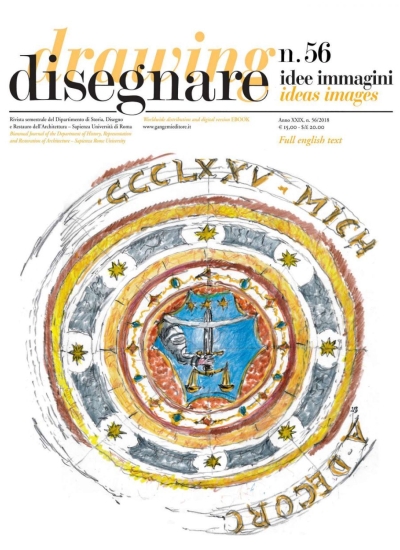 DISEGNARE IDEE IMMAGINI N° 56 / 2018
Rivista semestrale del Dipartimento di Storia, Disegno e Restauro dell'Architettura Sapienza Università di Roma
DISEGNARE IDEE IMMAGINI N° 56 / 2018
Rivista semestrale del Dipartimento di Storia, Disegno e Restauro dell'Architettura Sapienza Università di Roma
Luis Antonio García García, Gangemi Editore
 DISEGNARE IDEE IMMAGINI N° 56 / 2018
Rivista semestrale del Dipartimento di Storia, Disegno e Restauro dell'Architettura Sapienza Università di Roma
DISEGNARE IDEE IMMAGINI N° 56 / 2018
Rivista semestrale del Dipartimento di Storia, Disegno e Restauro dell'Architettura Sapienza Università di RomaLuis Antonio García García, Gangemi Editore
14,99 €
STORICIZZARE LA RAPPRESENTAZIONE ARCHITETTONICA
Published in Disegnare idee immagini 56/2018. Rivista semestrale del Dipartimento di Storia, Disegno e Restauro dell'Architettura Sapienza Università di Roma | Biannual Magazine of the Department of History, Drawing and Restoration of Architecture
Published in Disegnare idee immagini 56/2018. Rivista semestrale del Dipartimento di Storia, Disegno e Restauro dell'Architettura Sapienza Università di Roma | Biannual Magazine of the Department of History, Drawing and Restoration of Architecture
4.99 €
39
-41
 STORICIZZARE LA RAPPRESENTAZIONE ARCHITETTONICA
Published in Disegnare idee immagini 56/2018. Rivista semestrale del Dipartimento di Storia, Disegno e Restauro dell'Architettura Sapienza Università di Roma | Biannual Magazine of the Department of History, Drawing and Restoration of Architecture
STORICIZZARE LA RAPPRESENTAZIONE ARCHITETTONICA
Published in Disegnare idee immagini 56/2018. Rivista semestrale del Dipartimento di Storia, Disegno e Restauro dell'Architettura Sapienza Università di Roma | Biannual Magazine of the Department of History, Drawing and Restoration of Architecture
Mario Docci, Gangemi Editore
 STORICIZZARE LA RAPPRESENTAZIONE ARCHITETTONICA
Published in Disegnare idee immagini 56/2018. Rivista semestrale del Dipartimento di Storia, Disegno e Restauro dell'Architettura Sapienza Università di Roma | Biannual Magazine of the Department of History, Drawing and Restoration of Architecture
STORICIZZARE LA RAPPRESENTAZIONE ARCHITETTONICA
Published in Disegnare idee immagini 56/2018. Rivista semestrale del Dipartimento di Storia, Disegno e Restauro dell'Architettura Sapienza Università di Roma | Biannual Magazine of the Department of History, Drawing and Restoration of ArchitectureMario Docci, Gangemi Editore
4,99 €
DISEGNARE IDEE IMMAGINI N° 47 / 2013
Rivista semestrale del Dipartimento di Storia, Disegno e Restauro dell'Architettura "Sapienza" Università di Roma
Rivista semestrale del Dipartimento di Storia, Disegno e Restauro dell'Architettura "Sapienza" Università di Roma
Mario Docci,
Barbara Aterini,
Adriana Rossi,
Mohammad El-Khalili,
Nizar Al Adarbeh,
Yahya Al Shawabkeh,
Abdulraouf Mayyas,
Fabrizio Ivan Apollonio,
Simone Baldissini,
Guido Beltramini,
Maria Malvina Borgherini,
Paolo Clini,
Marco Gaiani,
Caterina Palestini,
Livio Sacchi,
Camillo Trevisan,
Carlo Bianchini,
Gaia Lisa Tacchi,
Laura Inzerillo,
Cettina Santagati
14.99 €
39
-41
 DISEGNARE IDEE IMMAGINI N° 47 / 2013
Rivista semestrale del Dipartimento di Storia, Disegno e Restauro dell'Architettura "Sapienza" Università di Roma
DISEGNARE IDEE IMMAGINI N° 47 / 2013
Rivista semestrale del Dipartimento di Storia, Disegno e Restauro dell'Architettura "Sapienza" Università di Roma
Mario Docci, Gangemi Editore
 DISEGNARE IDEE IMMAGINI N° 47 / 2013
Rivista semestrale del Dipartimento di Storia, Disegno e Restauro dell'Architettura "Sapienza" Università di Roma
DISEGNARE IDEE IMMAGINI N° 47 / 2013
Rivista semestrale del Dipartimento di Storia, Disegno e Restauro dell'Architettura "Sapienza" Università di RomaMario Docci, Gangemi Editore
14,99 €
DISEGNARE IDEE IMMAGINI N° 46 / 2013
Rivista semestrale del Dipartimento di Storia, Disegno e Restauro dell'Architettura Sapienza Università di Roma
Rivista semestrale del Dipartimento di Storia, Disegno e Restauro dell'Architettura Sapienza Università di Roma
29.99 €
39
-41
 DISEGNARE IDEE IMMAGINI N° 46 / 2013
Rivista semestrale del Dipartimento di Storia, Disegno e Restauro dell'Architettura Sapienza Università di Roma
DISEGNARE IDEE IMMAGINI N° 46 / 2013
Rivista semestrale del Dipartimento di Storia, Disegno e Restauro dell'Architettura Sapienza Università di Roma
Mario Docci, Gangemi Editore
 DISEGNARE IDEE IMMAGINI N° 46 / 2013
Rivista semestrale del Dipartimento di Storia, Disegno e Restauro dell'Architettura Sapienza Università di Roma
DISEGNARE IDEE IMMAGINI N° 46 / 2013
Rivista semestrale del Dipartimento di Storia, Disegno e Restauro dell'Architettura Sapienza Università di RomaMario Docci, Gangemi Editore
29,99 €
DISEGNARE IDEE IMMAGINI N° 36 / 2008
Rivista semestrale del Dipartimento di Rappresentazione e Rilievo dell'Università degli studi di Roma La Sapienza
Rivista semestrale del Dipartimento di Rappresentazione e Rilievo dell'Università degli studi di Roma La Sapienza
7.99 €
39
-41
 DISEGNARE IDEE IMMAGINI N° 36 / 2008
Rivista semestrale del Dipartimento di Rappresentazione e Rilievo dell'Università degli studi di Roma La Sapienza
DISEGNARE IDEE IMMAGINI N° 36 / 2008
Rivista semestrale del Dipartimento di Rappresentazione e Rilievo dell'Università degli studi di Roma La Sapienza
AA. VV., Gangemi Editore
 DISEGNARE IDEE IMMAGINI N° 36 / 2008
Rivista semestrale del Dipartimento di Rappresentazione e Rilievo dell'Università degli studi di Roma La Sapienza
DISEGNARE IDEE IMMAGINI N° 36 / 2008
Rivista semestrale del Dipartimento di Rappresentazione e Rilievo dell'Università degli studi di Roma La SapienzaAA. VV., Gangemi Editore
7,99 €
DISEGNARE IDEE IMMAGINI N° 51 / 2015
Rivista semestrale del Dipartimento di Storia, Disegno e Restauro dell'Architettura Sapienza Università di Roma
Rivista semestrale del Dipartimento di Storia, Disegno e Restauro dell'Architettura Sapienza Università di Roma
Mario Docci,
Maria Linda Falcidieno,
Mario Centofanti,
Leonardo Baglioni,
Gábor Üveges,
Emanuela Chiavoni,
Fernando Zaparaín,
Alessandro Viscogliosi,
Massimo Malagugini,
Leonardo Paris,
Carlo Inglese,
Laura De Carlo,
Jorge Ramos,
Maria Elisabetta Ruggiero,
Stefano Brusaporci,
Salvatore Barba,
Pamela Maiezza,
Maria Laura Rossi,
Antonio Álvaro
14.99 €
39
-41
 DISEGNARE IDEE IMMAGINI N° 51 / 2015
Rivista semestrale del Dipartimento di Storia, Disegno e Restauro dell'Architettura Sapienza Università di Roma
DISEGNARE IDEE IMMAGINI N° 51 / 2015
Rivista semestrale del Dipartimento di Storia, Disegno e Restauro dell'Architettura Sapienza Università di Roma
Mario Docci, Gangemi Editore
 DISEGNARE IDEE IMMAGINI N° 51 / 2015
Rivista semestrale del Dipartimento di Storia, Disegno e Restauro dell'Architettura Sapienza Università di Roma
DISEGNARE IDEE IMMAGINI N° 51 / 2015
Rivista semestrale del Dipartimento di Storia, Disegno e Restauro dell'Architettura Sapienza Università di RomaMario Docci, Gangemi Editore
14,99 €
DISEGNARE IDEE IMMAGINI N° 37 / 2008
Rivista semestrale del Dipartimento di Rappresentazione e Rilievo dell'Università degli studi di Roma La Sapienza
Rivista semestrale del Dipartimento di Rappresentazione e Rilievo dell'Università degli studi di Roma La Sapienza
7.99 €
39
-41
 DISEGNARE IDEE IMMAGINI N° 37 / 2008
Rivista semestrale del Dipartimento di Rappresentazione e Rilievo dell'Università degli studi di Roma La Sapienza
DISEGNARE IDEE IMMAGINI N° 37 / 2008
Rivista semestrale del Dipartimento di Rappresentazione e Rilievo dell'Università degli studi di Roma La Sapienza
AA. VV., Gangemi Editore
 DISEGNARE IDEE IMMAGINI N° 37 / 2008
Rivista semestrale del Dipartimento di Rappresentazione e Rilievo dell'Università degli studi di Roma La Sapienza
DISEGNARE IDEE IMMAGINI N° 37 / 2008
Rivista semestrale del Dipartimento di Rappresentazione e Rilievo dell'Università degli studi di Roma La SapienzaAA. VV., Gangemi Editore
7,99 €
VISIONE, PENSIERO, DISEGNI: GLI INSEGNAMENTI DI FRANCIS D. K. CHING | VISION, IDEAS, DRAWINGS: TEACHINGS BY FRANCIS D. K. CHING
Published in Disegnare idee immagini 49/2014. Rivista semestrale del Dipartimento di Storia, Disegno e Restauro dell’Architettura “Sapienza” Università di Roma | Biannual Magazine of the Department of History, Drawing and Restoration of Architecture
Published in Disegnare idee immagini 49/2014. Rivista semestrale del Dipartimento di Storia, Disegno e Restauro dell’Architettura “Sapienza” Università di Roma | Biannual Magazine of the Department of History, Drawing and Restoration of Architecture
4.99 €
39
-41
 VISIONE, PENSIERO, DISEGNI: GLI INSEGNAMENTI DI FRANCIS D. K. CHING | VISION, IDEAS, DRAWINGS: TEACHINGS BY FRANCIS D. K. CHING
Published in Disegnare idee immagini 49/2014. Rivista semestrale del Dipartimento di Storia, Disegno e Restauro dell’Architettura “Sapienza” Università di Roma | Biannual Magazine of the Department of History, Drawing and Restoration of Architecture
VISIONE, PENSIERO, DISEGNI: GLI INSEGNAMENTI DI FRANCIS D. K. CHING | VISION, IDEAS, DRAWINGS: TEACHINGS BY FRANCIS D. K. CHING
Published in Disegnare idee immagini 49/2014. Rivista semestrale del Dipartimento di Storia, Disegno e Restauro dell’Architettura “Sapienza” Università di Roma | Biannual Magazine of the Department of History, Drawing and Restoration of Architecture
Emanuela Chiavoni, Gangemi Editore
 VISIONE, PENSIERO, DISEGNI: GLI INSEGNAMENTI DI FRANCIS D. K. CHING | VISION, IDEAS, DRAWINGS: TEACHINGS BY FRANCIS D. K. CHING
Published in Disegnare idee immagini 49/2014. Rivista semestrale del Dipartimento di Storia, Disegno e Restauro dell’Architettura “Sapienza” Università di Roma | Biannual Magazine of the Department of History, Drawing and Restoration of Architecture
VISIONE, PENSIERO, DISEGNI: GLI INSEGNAMENTI DI FRANCIS D. K. CHING | VISION, IDEAS, DRAWINGS: TEACHINGS BY FRANCIS D. K. CHING
Published in Disegnare idee immagini 49/2014. Rivista semestrale del Dipartimento di Storia, Disegno e Restauro dell’Architettura “Sapienza” Università di Roma | Biannual Magazine of the Department of History, Drawing and Restoration of ArchitectureEmanuela Chiavoni, Gangemi Editore
4,99 €
DISEGNO, COLORE E PROGETTO NELLE OPERE DI GUGLIELMO MOZZONI | DRAWING, COLOUR AND DESIGN IN WORKS BY GUGLIELMO MOZZONI
Published in Disegnare idee immagini 48/2014. Rivista semestrale del Dipartimento di Storia, Disegno e Restauro dell’Architettura “Sapienza” Università di Roma | Biannual Magazine of the Department of History, Drawing and Restoration of Architecture
Published in Disegnare idee immagini 48/2014. Rivista semestrale del Dipartimento di Storia, Disegno e Restauro dell’Architettura “Sapienza” Università di Roma | Biannual Magazine of the Department of History, Drawing and Restoration of Architecture
4.99 €
39
-41
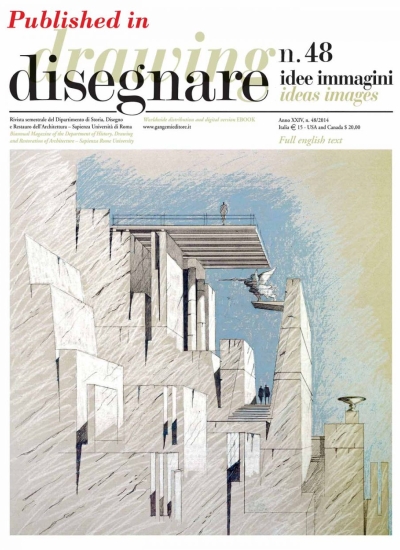 DISEGNO, COLORE E PROGETTO NELLE OPERE DI GUGLIELMO MOZZONI | DRAWING, COLOUR AND DESIGN IN WORKS BY GUGLIELMO MOZZONI
Published in Disegnare idee immagini 48/2014. Rivista semestrale del Dipartimento di Storia, Disegno e Restauro dell’Architettura “Sapienza” Università di Roma | Biannual Magazine of the Department of History, Drawing and Restoration of Architecture
DISEGNO, COLORE E PROGETTO NELLE OPERE DI GUGLIELMO MOZZONI | DRAWING, COLOUR AND DESIGN IN WORKS BY GUGLIELMO MOZZONI
Published in Disegnare idee immagini 48/2014. Rivista semestrale del Dipartimento di Storia, Disegno e Restauro dell’Architettura “Sapienza” Università di Roma | Biannual Magazine of the Department of History, Drawing and Restoration of Architecture
Tatiana Kirilova Kirova, Gangemi Editore
 DISEGNO, COLORE E PROGETTO NELLE OPERE DI GUGLIELMO MOZZONI | DRAWING, COLOUR AND DESIGN IN WORKS BY GUGLIELMO MOZZONI
Published in Disegnare idee immagini 48/2014. Rivista semestrale del Dipartimento di Storia, Disegno e Restauro dell’Architettura “Sapienza” Università di Roma | Biannual Magazine of the Department of History, Drawing and Restoration of Architecture
DISEGNO, COLORE E PROGETTO NELLE OPERE DI GUGLIELMO MOZZONI | DRAWING, COLOUR AND DESIGN IN WORKS BY GUGLIELMO MOZZONI
Published in Disegnare idee immagini 48/2014. Rivista semestrale del Dipartimento di Storia, Disegno e Restauro dell’Architettura “Sapienza” Università di Roma | Biannual Magazine of the Department of History, Drawing and Restoration of ArchitectureTatiana Kirilova Kirova, Gangemi Editore
4,99 €
DISEGNARE IDEE IMMAGINI N° 52 / 2016
Rivista semestrale del Dipartimento di Storia, Disegno e Restauro dell'Architettura Sapienza Università di Roma
Rivista semestrale del Dipartimento di Storia, Disegno e Restauro dell'Architettura Sapienza Università di Roma
14.99 €
39
-41
 DISEGNARE IDEE IMMAGINI N° 52 / 2016
Rivista semestrale del Dipartimento di Storia, Disegno e Restauro dell'Architettura Sapienza Università di Roma
DISEGNARE IDEE IMMAGINI N° 52 / 2016
Rivista semestrale del Dipartimento di Storia, Disegno e Restauro dell'Architettura Sapienza Università di Roma
Paolo Portoghesi, Gangemi Editore
 DISEGNARE IDEE IMMAGINI N° 52 / 2016
Rivista semestrale del Dipartimento di Storia, Disegno e Restauro dell'Architettura Sapienza Università di Roma
DISEGNARE IDEE IMMAGINI N° 52 / 2016
Rivista semestrale del Dipartimento di Storia, Disegno e Restauro dell'Architettura Sapienza Università di RomaPaolo Portoghesi, Gangemi Editore
14,99 €
DISEGNARE IDEE IMMAGINI N° 53 / 2016
Rivista semestrale del Dipartimento di Storia, Disegno e Restauro dell'Architettura Sapienza Università di Roma
Rivista semestrale del Dipartimento di Storia, Disegno e Restauro dell'Architettura Sapienza Università di Roma
Mario Docci,
Luis Agustín Hernández,
Lucio Altarelli,
Katarina Andjelkovic,
Fabrizio Ivan Apollonio,
Carlo Bianchini,
Ignacio Bosch Reig,
Ignacio Cabodevilla-Artieda,
Teresa Della Corte,
Mario Docci,
Riccardo Foschi,
Marco Gaiani,
Marta Grau Fernandez,
Francisco Martínez Mindeguía,
Antonio Saggio,
Gabriele Stancato,
Aurelio Vallespín Muniesa
14.99 €
39
-41
 DISEGNARE IDEE IMMAGINI N° 53 / 2016
Rivista semestrale del Dipartimento di Storia, Disegno e Restauro dell'Architettura Sapienza Università di Roma
DISEGNARE IDEE IMMAGINI N° 53 / 2016
Rivista semestrale del Dipartimento di Storia, Disegno e Restauro dell'Architettura Sapienza Università di Roma
Mario Docci, Gangemi Editore
 DISEGNARE IDEE IMMAGINI N° 53 / 2016
Rivista semestrale del Dipartimento di Storia, Disegno e Restauro dell'Architettura Sapienza Università di Roma
DISEGNARE IDEE IMMAGINI N° 53 / 2016
Rivista semestrale del Dipartimento di Storia, Disegno e Restauro dell'Architettura Sapienza Università di RomaMario Docci, Gangemi Editore
14,99 €
EDITORIALE – IL RUOLO DEI MODELLI VIRTUALI 3D NELLA CONSERVAZIONE DEL PATRIMONIO ARCHITETTONICO E ARCHEOLOGICO | EDITORIAL - THE ROLE OF VIRTUAL 3D MODELS IN THE CONSERVATION OF ARCHITECTURAL AND ARCHAEOLOGICAL HERITAGE
Published in Disegnare idee immagini 53/2016. Rivista semestrale del Dipartimento di Storia, Disegno e Restauro dell’Architettura “Sapienza” Università di Roma | Biannual Magazine of the Department of History, Drawing and Restoration of Architecture
Published in Disegnare idee immagini 53/2016. Rivista semestrale del Dipartimento di Storia, Disegno e Restauro dell’Architettura “Sapienza” Università di Roma | Biannual Magazine of the Department of History, Drawing and Restoration of Architecture
4.99 €
39
-41
 EDITORIALE – IL RUOLO DEI MODELLI VIRTUALI 3D NELLA CONSERVAZIONE DEL PATRIMONIO ARCHITETTONICO E ARCHEOLOGICO | EDITORIAL - THE ROLE OF VIRTUAL 3D MODELS IN THE CONSERVATION OF ARCHITECTURAL AND ARCHAEOLOGICAL HERITAGE
Published in Disegnare idee immagini 53/2016. Rivista semestrale del Dipartimento di Storia, Disegno e Restauro dell’Architettura “Sapienza” Università di Roma | Biannual Magazine of the Department of History, Drawing and Restoration of Architecture
EDITORIALE – IL RUOLO DEI MODELLI VIRTUALI 3D NELLA CONSERVAZIONE DEL PATRIMONIO ARCHITETTONICO E ARCHEOLOGICO | EDITORIAL - THE ROLE OF VIRTUAL 3D MODELS IN THE CONSERVATION OF ARCHITECTURAL AND ARCHAEOLOGICAL HERITAGE
Published in Disegnare idee immagini 53/2016. Rivista semestrale del Dipartimento di Storia, Disegno e Restauro dell’Architettura “Sapienza” Università di Roma | Biannual Magazine of the Department of History, Drawing and Restoration of Architecture
Mario Docci, Gangemi Editore
 EDITORIALE – IL RUOLO DEI MODELLI VIRTUALI 3D NELLA CONSERVAZIONE DEL PATRIMONIO ARCHITETTONICO E ARCHEOLOGICO | EDITORIAL - THE ROLE OF VIRTUAL 3D MODELS IN THE CONSERVATION OF ARCHITECTURAL AND ARCHAEOLOGICAL HERITAGE
Published in Disegnare idee immagini 53/2016. Rivista semestrale del Dipartimento di Storia, Disegno e Restauro dell’Architettura “Sapienza” Università di Roma | Biannual Magazine of the Department of History, Drawing and Restoration of Architecture
EDITORIALE – IL RUOLO DEI MODELLI VIRTUALI 3D NELLA CONSERVAZIONE DEL PATRIMONIO ARCHITETTONICO E ARCHEOLOGICO | EDITORIAL - THE ROLE OF VIRTUAL 3D MODELS IN THE CONSERVATION OF ARCHITECTURAL AND ARCHAEOLOGICAL HERITAGE
Published in Disegnare idee immagini 53/2016. Rivista semestrale del Dipartimento di Storia, Disegno e Restauro dell’Architettura “Sapienza” Università di Roma | Biannual Magazine of the Department of History, Drawing and Restoration of ArchitectureMario Docci, Gangemi Editore
4,99 €
DISEGNARE IDEE IMMAGINI N° 54 / 2017
Rivista semestrale del Dipartimento di Storia, Disegno e Restauro dell'Architettura Sapienza Università di Roma
Rivista semestrale del Dipartimento di Storia, Disegno e Restauro dell'Architettura Sapienza Università di Roma
14.99 €
39
-41
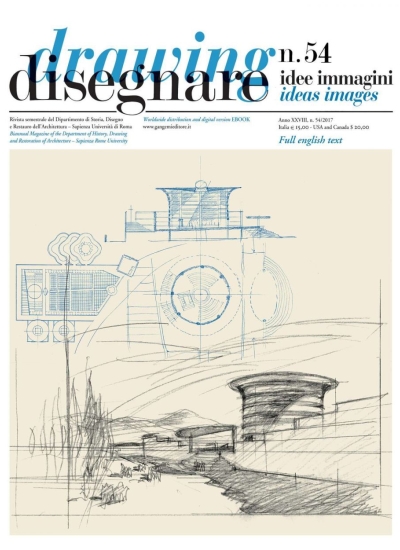 DISEGNARE IDEE IMMAGINI N° 54 / 2017
Rivista semestrale del Dipartimento di Storia, Disegno e Restauro dell'Architettura Sapienza Università di Roma
DISEGNARE IDEE IMMAGINI N° 54 / 2017
Rivista semestrale del Dipartimento di Storia, Disegno e Restauro dell'Architettura Sapienza Università di Roma
Mario Docci, Gangemi Editore
 DISEGNARE IDEE IMMAGINI N° 54 / 2017
Rivista semestrale del Dipartimento di Storia, Disegno e Restauro dell'Architettura Sapienza Università di Roma
DISEGNARE IDEE IMMAGINI N° 54 / 2017
Rivista semestrale del Dipartimento di Storia, Disegno e Restauro dell'Architettura Sapienza Università di RomaMario Docci, Gangemi Editore
14,99 €
LA QUALITÀ DELLA RICERCA SCIENTIFICA NEL SETTORE DEL DISEGNO SI PUÒ E SI DEVE MISURARE
Published in Disegnare idee immagini 54/2017. Rivista semestrale del Dipartimento di Storia, Disegno e Restauro dell’Architettura “Sapienza” Università di Roma | Biannual Magazine of the Department of History, Drawing and Restoration of Architecture
Published in Disegnare idee immagini 54/2017. Rivista semestrale del Dipartimento di Storia, Disegno e Restauro dell’Architettura “Sapienza” Università di Roma | Biannual Magazine of the Department of History, Drawing and Restoration of Architecture
4.99 €
39
-41
 LA QUALITÀ DELLA RICERCA SCIENTIFICA NEL SETTORE DEL DISEGNO SI PUÒ E SI DEVE MISURARE
Published in Disegnare idee immagini 54/2017. Rivista semestrale del Dipartimento di Storia, Disegno e Restauro dell’Architettura “Sapienza” Università di Roma | Biannual Magazine of the Department of History, Drawing and Restoration of Architecture
LA QUALITÀ DELLA RICERCA SCIENTIFICA NEL SETTORE DEL DISEGNO SI PUÒ E SI DEVE MISURARE
Published in Disegnare idee immagini 54/2017. Rivista semestrale del Dipartimento di Storia, Disegno e Restauro dell’Architettura “Sapienza” Università di Roma | Biannual Magazine of the Department of History, Drawing and Restoration of Architecture
Mario Docci, Gangemi Editore
 LA QUALITÀ DELLA RICERCA SCIENTIFICA NEL SETTORE DEL DISEGNO SI PUÒ E SI DEVE MISURARE
Published in Disegnare idee immagini 54/2017. Rivista semestrale del Dipartimento di Storia, Disegno e Restauro dell’Architettura “Sapienza” Università di Roma | Biannual Magazine of the Department of History, Drawing and Restoration of Architecture
LA QUALITÀ DELLA RICERCA SCIENTIFICA NEL SETTORE DEL DISEGNO SI PUÒ E SI DEVE MISURARE
Published in Disegnare idee immagini 54/2017. Rivista semestrale del Dipartimento di Storia, Disegno e Restauro dell’Architettura “Sapienza” Università di Roma | Biannual Magazine of the Department of History, Drawing and Restoration of ArchitectureMario Docci, Gangemi Editore
4,99 €
EDITORIALE. LA QUALITÀ DELLA RICERCA NELLE SCUOLE DI ARCHITETTURA ITALIANE
Published in Disegnare idee immagini 55/2017. Rivista semestrale del Dipartimento di Storia, Disegno e Restauro dell'Architettura Sapienza Università di Roma | Biannual Magazine of the Department of History, Drawing and Restoration of Architecture
Published in Disegnare idee immagini 55/2017. Rivista semestrale del Dipartimento di Storia, Disegno e Restauro dell'Architettura Sapienza Università di Roma | Biannual Magazine of the Department of History, Drawing and Restoration of Architecture
4.99 €
39
-41
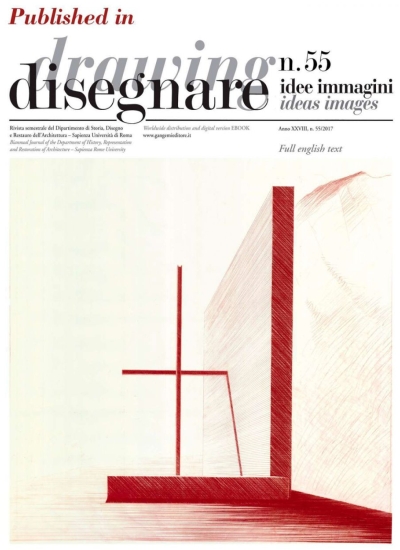 EDITORIALE. LA QUALITÀ DELLA RICERCA NELLE SCUOLE DI ARCHITETTURA ITALIANE
Published in Disegnare idee immagini 55/2017. Rivista semestrale del Dipartimento di Storia, Disegno e Restauro dell'Architettura Sapienza Università di Roma | Biannual Magazine of the Department of History, Drawing and Restoration of Architecture
EDITORIALE. LA QUALITÀ DELLA RICERCA NELLE SCUOLE DI ARCHITETTURA ITALIANE
Published in Disegnare idee immagini 55/2017. Rivista semestrale del Dipartimento di Storia, Disegno e Restauro dell'Architettura Sapienza Università di Roma | Biannual Magazine of the Department of History, Drawing and Restoration of Architecture
Mario Docci, Gangemi Editore
 EDITORIALE. LA QUALITÀ DELLA RICERCA NELLE SCUOLE DI ARCHITETTURA ITALIANE
Published in Disegnare idee immagini 55/2017. Rivista semestrale del Dipartimento di Storia, Disegno e Restauro dell'Architettura Sapienza Università di Roma | Biannual Magazine of the Department of History, Drawing and Restoration of Architecture
EDITORIALE. LA QUALITÀ DELLA RICERCA NELLE SCUOLE DI ARCHITETTURA ITALIANE
Published in Disegnare idee immagini 55/2017. Rivista semestrale del Dipartimento di Storia, Disegno e Restauro dell'Architettura Sapienza Università di Roma | Biannual Magazine of the Department of History, Drawing and Restoration of ArchitectureMario Docci, Gangemi Editore
4,99 €
DISEGNARE IDEE IMMAGINI N° 57 / 2018
Rivista semestrale del Dipartimento di Storia, Disegno e Restauro dell'Architettura Sapienza Università di Roma
Rivista semestrale del Dipartimento di Storia, Disegno e Restauro dell'Architettura Sapienza Università di Roma
14.99 €
39
-41
 DISEGNARE IDEE IMMAGINI N° 57 / 2018
Rivista semestrale del Dipartimento di Storia, Disegno e Restauro dell'Architettura Sapienza Università di Roma
DISEGNARE IDEE IMMAGINI N° 57 / 2018
Rivista semestrale del Dipartimento di Storia, Disegno e Restauro dell'Architettura Sapienza Università di Roma
Mario Docci, Gangemi Editore
 DISEGNARE IDEE IMMAGINI N° 57 / 2018
Rivista semestrale del Dipartimento di Storia, Disegno e Restauro dell'Architettura Sapienza Università di Roma
DISEGNARE IDEE IMMAGINI N° 57 / 2018
Rivista semestrale del Dipartimento di Storia, Disegno e Restauro dell'Architettura Sapienza Università di RomaMario Docci, Gangemi Editore
14,99 €
LA DOCUMENTAZIONE DEI TEATRI ANTICHI DEL MEDITERRANEO. LE ATTIVITÀ DEL PROGETTO ATHENA A MÉRIDA
Documentation of Mediterranean Ancient Theatres. Athena's Activities in Mérida
Documentation of Mediterranean Ancient Theatres. Athena's Activities in Mérida
25.99 €
39
-41
 LA DOCUMENTAZIONE DEI TEATRI ANTICHI DEL MEDITERRANEO. LE ATTIVITÀ DEL PROGETTO ATHENA A MÉRIDA
Documentation of Mediterranean Ancient Theatres. Athena's Activities in Mérida
LA DOCUMENTAZIONE DEI TEATRI ANTICHI DEL MEDITERRANEO. LE ATTIVITÀ DEL PROGETTO ATHENA A MÉRIDA
Documentation of Mediterranean Ancient Theatres. Athena's Activities in Mérida
Carlo Bianchini, Gangemi Editore
 LA DOCUMENTAZIONE DEI TEATRI ANTICHI DEL MEDITERRANEO. LE ATTIVITÀ DEL PROGETTO ATHENA A MÉRIDA
Documentation of Mediterranean Ancient Theatres. Athena's Activities in Mérida
LA DOCUMENTAZIONE DEI TEATRI ANTICHI DEL MEDITERRANEO. LE ATTIVITÀ DEL PROGETTO ATHENA A MÉRIDA
Documentation of Mediterranean Ancient Theatres. Athena's Activities in MéridaCarlo Bianchini, Gangemi Editore
25,99 €
METODI E TECNICHE INTEGRATE DI RILEVAMENTO PER LA REALIZZAZIONE DI MODELLI VIRTUALI DELL'ARCHITETTURA DELLA CITTÀ
Ricerca COFIN 2004. Coordinatore nazionale Mario Docci
Ricerca COFIN 2004. Coordinatore nazionale Mario Docci
Emanuela Chiavoni,
Priscilla Paolini,
Luigi Affuso,
Piero Albisinni,
Claudio Alessandri,
Barbara Aterini,
Adriana Baculo,
Marcello Balzani,
Maria Teresa Bartoli,
Antonello Bello,
Carlo Bianchini,
Lorenza Bologna,
Lucia Bonanno,
Fausto Brevi,
Massimiliano Campi,
Emanuela Chiavoni,
Michela Cigola,
Roberto Corazzi,
Carmela Crescenzi,
Laura De Carlo,
Mariella Dell'Aquila,
Antonella di Luggo,
Mario Docci,
Riccardo Florio,
Elena Fossi,
Marco Gaiani,
Gabriele Guidi,
Laura Inzerillo,
Michele Inzerillo,
Alfonso Ippolito,
Marco Jaff,
Fabio Lanfranchi,
Emma Mandelli,
Lorenzo Martella,
Sara Mattei,
Giampiero Mele,
Carlo Mezzetti,
Alessandro Micucci,
Enrico Milani,
Ruggero Morichi,
Caterina Palestini,
Adriana Paolillo,
Priscilla Paolini,
Lia Maria Papa,
Assunta Pelliccio,
Sara Peluso,
Silvia Petrucci,
Maria Rita Pizzurro,
Paola Puma,
Antonella Salucci,
Salvatore Santuccio,
Marcello Scalzo,
Francesco Scirè,
Filippo Terranova,
Lycia Trapani,
Maurizio Unali,
Marcello Vannucchi,
Uliva Velo,
Giuseppe Verde
39.99 €
39
-41
 METODI E TECNICHE INTEGRATE DI RILEVAMENTO PER LA REALIZZAZIONE DI MODELLI VIRTUALI DELL'ARCHITETTURA DELLA CITTÀ
Ricerca COFIN 2004. Coordinatore nazionale Mario Docci
METODI E TECNICHE INTEGRATE DI RILEVAMENTO PER LA REALIZZAZIONE DI MODELLI VIRTUALI DELL'ARCHITETTURA DELLA CITTÀ
Ricerca COFIN 2004. Coordinatore nazionale Mario Docci
Emanuela Chiavoni, Gangemi Editore
 METODI E TECNICHE INTEGRATE DI RILEVAMENTO PER LA REALIZZAZIONE DI MODELLI VIRTUALI DELL'ARCHITETTURA DELLA CITTÀ
Ricerca COFIN 2004. Coordinatore nazionale Mario Docci
METODI E TECNICHE INTEGRATE DI RILEVAMENTO PER LA REALIZZAZIONE DI MODELLI VIRTUALI DELL'ARCHITETTURA DELLA CITTÀ
Ricerca COFIN 2004. Coordinatore nazionale Mario DocciEmanuela Chiavoni, Gangemi Editore
39,99 €
DISEGNARE IDEE IMMAGINI N° 55 / 2017
Rivista semestrale del Dipartimento di Storia, Disegno e Restauro dell'Architettura Sapienza Università di Roma
Rivista semestrale del Dipartimento di Storia, Disegno e Restauro dell'Architettura Sapienza Università di Roma
Mario Docci,
Maria Letizia Accorsi,
Lisa Accurti,
Carlo Bianchini,
Pedro M. Cabezos Bernal,
Eduardo Carazo Lefort,
Laura Carnevali,
Mario Docci,
Noella Galván Desvaux,
Carlo Inglese,
Elena Ippoliti,
Fabio Lanfranchi,
Francisco Martínez Mindeguía,
Marco Muscogiuri,
Leonardo Paris,
Marta Alonso Rodríguez,
Adriana Rossi,
Martina Trentani,
Paolo Zermani
14.99 €
39
-41
 DISEGNARE IDEE IMMAGINI N° 55 / 2017
Rivista semestrale del Dipartimento di Storia, Disegno e Restauro dell'Architettura Sapienza Università di Roma
DISEGNARE IDEE IMMAGINI N° 55 / 2017
Rivista semestrale del Dipartimento di Storia, Disegno e Restauro dell'Architettura Sapienza Università di Roma
Mario Docci, Gangemi Editore
 DISEGNARE IDEE IMMAGINI N° 55 / 2017
Rivista semestrale del Dipartimento di Storia, Disegno e Restauro dell'Architettura Sapienza Università di Roma
DISEGNARE IDEE IMMAGINI N° 55 / 2017
Rivista semestrale del Dipartimento di Storia, Disegno e Restauro dell'Architettura Sapienza Università di RomaMario Docci, Gangemi Editore
14,99 €
IL RILIEVO COME SISTEMA DI CONOSCENZA: LA CASA DEI CAVALIERI DI RODI | SURVEY AS A KNOWLEDGE SYSTEM: THE HOUSE OF THE KNIGHTS OF RHODES
Published in Disegnare idee immagini 47/2013. Rivista semestrale del Dipartimento di Storia, Disegno e Restauro dell’Architettura “Sapienza” Università di Roma | Biannual Magazine of the Department of History, Drawing and Restoration of Architecture
Published in Disegnare idee immagini 47/2013. Rivista semestrale del Dipartimento di Storia, Disegno e Restauro dell’Architettura “Sapienza” Università di Roma | Biannual Magazine of the Department of History, Drawing and Restoration of Architecture
4.99 €
39
-41
 IL RILIEVO COME SISTEMA DI CONOSCENZA: LA CASA DEI CAVALIERI DI RODI | SURVEY AS A KNOWLEDGE SYSTEM: THE HOUSE OF THE KNIGHTS OF RHODES
Published in Disegnare idee immagini 47/2013. Rivista semestrale del Dipartimento di Storia, Disegno e Restauro dell’Architettura “Sapienza” Università di Roma | Biannual Magazine of the Department of History, Drawing and Restoration of Architecture
IL RILIEVO COME SISTEMA DI CONOSCENZA: LA CASA DEI CAVALIERI DI RODI | SURVEY AS A KNOWLEDGE SYSTEM: THE HOUSE OF THE KNIGHTS OF RHODES
Published in Disegnare idee immagini 47/2013. Rivista semestrale del Dipartimento di Storia, Disegno e Restauro dell’Architettura “Sapienza” Università di Roma | Biannual Magazine of the Department of History, Drawing and Restoration of Architecture
Carlo Bianchini, Gangemi Editore
 IL RILIEVO COME SISTEMA DI CONOSCENZA: LA CASA DEI CAVALIERI DI RODI | SURVEY AS A KNOWLEDGE SYSTEM: THE HOUSE OF THE KNIGHTS OF RHODES
Published in Disegnare idee immagini 47/2013. Rivista semestrale del Dipartimento di Storia, Disegno e Restauro dell’Architettura “Sapienza” Università di Roma | Biannual Magazine of the Department of History, Drawing and Restoration of Architecture
IL RILIEVO COME SISTEMA DI CONOSCENZA: LA CASA DEI CAVALIERI DI RODI | SURVEY AS A KNOWLEDGE SYSTEM: THE HOUSE OF THE KNIGHTS OF RHODES
Published in Disegnare idee immagini 47/2013. Rivista semestrale del Dipartimento di Storia, Disegno e Restauro dell’Architettura “Sapienza” Università di Roma | Biannual Magazine of the Department of History, Drawing and Restoration of ArchitectureCarlo Bianchini, Gangemi Editore
4,99 €
DISEGNARE IDEE IMMAGINI N° 47 / 2013
Rivista semestrale del Dipartimento di Storia, Disegno e Restauro dell'Architettura "Sapienza" Università di Roma
Rivista semestrale del Dipartimento di Storia, Disegno e Restauro dell'Architettura "Sapienza" Università di Roma
Mario Docci,
Barbara Aterini,
Adriana Rossi,
Mohammad El-Khalili,
Nizar Al Adarbeh,
Yahya Al Shawabkeh,
Abdulraouf Mayyas,
Fabrizio Ivan Apollonio,
Simone Baldissini,
Guido Beltramini,
Maria Malvina Borgherini,
Paolo Clini,
Marco Gaiani,
Caterina Palestini,
Livio Sacchi,
Camillo Trevisan,
Carlo Bianchini,
Gaia Lisa Tacchi,
Laura Inzerillo,
Cettina Santagati
14.99 €
39
-41
 DISEGNARE IDEE IMMAGINI N° 47 / 2013
Rivista semestrale del Dipartimento di Storia, Disegno e Restauro dell'Architettura "Sapienza" Università di Roma
DISEGNARE IDEE IMMAGINI N° 47 / 2013
Rivista semestrale del Dipartimento di Storia, Disegno e Restauro dell'Architettura "Sapienza" Università di Roma
Mario Docci, Gangemi Editore
 DISEGNARE IDEE IMMAGINI N° 47 / 2013
Rivista semestrale del Dipartimento di Storia, Disegno e Restauro dell'Architettura "Sapienza" Università di Roma
DISEGNARE IDEE IMMAGINI N° 47 / 2013
Rivista semestrale del Dipartimento di Storia, Disegno e Restauro dell'Architettura "Sapienza" Università di RomaMario Docci, Gangemi Editore
14,99 €
BOOK NUMBER: UNO STRUMENTO PER L'ORGANIZZAZIONE DELLE COLLEZIONI
Manuale ad uso dei bibliotecari
Manuale ad uso dei bibliotecari
10.99 €
39
-41
 BOOK NUMBER: UNO STRUMENTO PER L'ORGANIZZAZIONE DELLE COLLEZIONI
Manuale ad uso dei bibliotecari
BOOK NUMBER: UNO STRUMENTO PER L'ORGANIZZAZIONE DELLE COLLEZIONI
Manuale ad uso dei bibliotecari
Carlo Bianchini, Editrice Bibliografica
 BOOK NUMBER: UNO STRUMENTO PER L'ORGANIZZAZIONE DELLE COLLEZIONI
Manuale ad uso dei bibliotecari
BOOK NUMBER: UNO STRUMENTO PER L'ORGANIZZAZIONE DELLE COLLEZIONI
Manuale ad uso dei bibliotecariCarlo Bianchini, Editrice Bibliografica
10,99 €
39
-41
 INTRODUZIONE A RDA
Linee guida per rappresentare e scoprire le risorse
INTRODUZIONE A RDA
Linee guida per rappresentare e scoprire le risorse
Mauro Guerrini, Editrice Bibliografica
 INTRODUZIONE A RDA
Linee guida per rappresentare e scoprire le risorse
INTRODUZIONE A RDA
Linee guida per rappresentare e scoprire le risorseMauro Guerrini, Editrice Bibliografica
15,99 €
39
-41
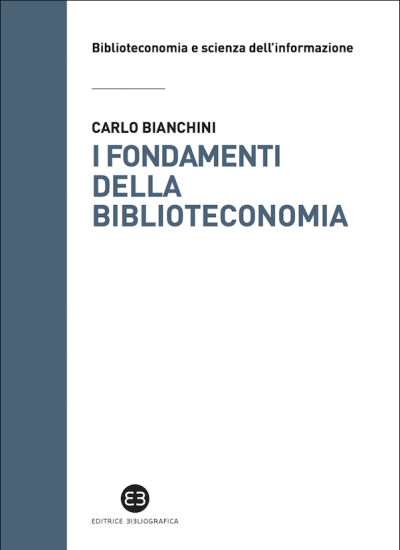 I FONDAMENTI DELLA BIBLIOTECONOMIA
Attualità del pensiero di S.R. Ranganathan
I FONDAMENTI DELLA BIBLIOTECONOMIA
Attualità del pensiero di S.R. Ranganathan
Carlo Bianchini, Editrice Bibliografica
 I FONDAMENTI DELLA BIBLIOTECONOMIA
Attualità del pensiero di S.R. Ranganathan
I FONDAMENTI DELLA BIBLIOTECONOMIA
Attualità del pensiero di S.R. RanganathanCarlo Bianchini, Editrice Bibliografica
18,99 €
DISEGNARE IDEE IMMAGINI N° 53 / 2016
Rivista semestrale del Dipartimento di Storia, Disegno e Restauro dell'Architettura Sapienza Università di Roma
Rivista semestrale del Dipartimento di Storia, Disegno e Restauro dell'Architettura Sapienza Università di Roma
Mario Docci,
Luis Agustín Hernández,
Lucio Altarelli,
Katarina Andjelkovic,
Fabrizio Ivan Apollonio,
Carlo Bianchini,
Ignacio Bosch Reig,
Ignacio Cabodevilla-Artieda,
Teresa Della Corte,
Mario Docci,
Riccardo Foschi,
Marco Gaiani,
Marta Grau Fernandez,
Francisco Martínez Mindeguía,
Antonio Saggio,
Gabriele Stancato,
Aurelio Vallespín Muniesa
14.99 €
39
-41
 DISEGNARE IDEE IMMAGINI N° 53 / 2016
Rivista semestrale del Dipartimento di Storia, Disegno e Restauro dell'Architettura Sapienza Università di Roma
DISEGNARE IDEE IMMAGINI N° 53 / 2016
Rivista semestrale del Dipartimento di Storia, Disegno e Restauro dell'Architettura Sapienza Università di Roma
Mario Docci, Gangemi Editore
 DISEGNARE IDEE IMMAGINI N° 53 / 2016
Rivista semestrale del Dipartimento di Storia, Disegno e Restauro dell'Architettura Sapienza Università di Roma
DISEGNARE IDEE IMMAGINI N° 53 / 2016
Rivista semestrale del Dipartimento di Storia, Disegno e Restauro dell'Architettura Sapienza Università di RomaMario Docci, Gangemi Editore
14,99 €
EDITORIALE – IL RUOLO DEI MODELLI VIRTUALI 3D NELLA CONSERVAZIONE DEL PATRIMONIO ARCHITETTONICO E ARCHEOLOGICO | EDITORIAL - THE ROLE OF VIRTUAL 3D MODELS IN THE CONSERVATION OF ARCHITECTURAL AND ARCHAEOLOGICAL HERITAGE
Published in Disegnare idee immagini 53/2016. Rivista semestrale del Dipartimento di Storia, Disegno e Restauro dell’Architettura “Sapienza” Università di Roma | Biannual Magazine of the Department of History, Drawing and Restoration of Architecture
Published in Disegnare idee immagini 53/2016. Rivista semestrale del Dipartimento di Storia, Disegno e Restauro dell’Architettura “Sapienza” Università di Roma | Biannual Magazine of the Department of History, Drawing and Restoration of Architecture
4.99 €
39
-41
 EDITORIALE – IL RUOLO DEI MODELLI VIRTUALI 3D NELLA CONSERVAZIONE DEL PATRIMONIO ARCHITETTONICO E ARCHEOLOGICO | EDITORIAL - THE ROLE OF VIRTUAL 3D MODELS IN THE CONSERVATION OF ARCHITECTURAL AND ARCHAEOLOGICAL HERITAGE
Published in Disegnare idee immagini 53/2016. Rivista semestrale del Dipartimento di Storia, Disegno e Restauro dell’Architettura “Sapienza” Università di Roma | Biannual Magazine of the Department of History, Drawing and Restoration of Architecture
EDITORIALE – IL RUOLO DEI MODELLI VIRTUALI 3D NELLA CONSERVAZIONE DEL PATRIMONIO ARCHITETTONICO E ARCHEOLOGICO | EDITORIAL - THE ROLE OF VIRTUAL 3D MODELS IN THE CONSERVATION OF ARCHITECTURAL AND ARCHAEOLOGICAL HERITAGE
Published in Disegnare idee immagini 53/2016. Rivista semestrale del Dipartimento di Storia, Disegno e Restauro dell’Architettura “Sapienza” Università di Roma | Biannual Magazine of the Department of History, Drawing and Restoration of Architecture
Mario Docci, Gangemi Editore
 EDITORIALE – IL RUOLO DEI MODELLI VIRTUALI 3D NELLA CONSERVAZIONE DEL PATRIMONIO ARCHITETTONICO E ARCHEOLOGICO | EDITORIAL - THE ROLE OF VIRTUAL 3D MODELS IN THE CONSERVATION OF ARCHITECTURAL AND ARCHAEOLOGICAL HERITAGE
Published in Disegnare idee immagini 53/2016. Rivista semestrale del Dipartimento di Storia, Disegno e Restauro dell’Architettura “Sapienza” Università di Roma | Biannual Magazine of the Department of History, Drawing and Restoration of Architecture
EDITORIALE – IL RUOLO DEI MODELLI VIRTUALI 3D NELLA CONSERVAZIONE DEL PATRIMONIO ARCHITETTONICO E ARCHEOLOGICO | EDITORIAL - THE ROLE OF VIRTUAL 3D MODELS IN THE CONSERVATION OF ARCHITECTURAL AND ARCHAEOLOGICAL HERITAGE
Published in Disegnare idee immagini 53/2016. Rivista semestrale del Dipartimento di Storia, Disegno e Restauro dell’Architettura “Sapienza” Università di Roma | Biannual Magazine of the Department of History, Drawing and Restoration of ArchitectureMario Docci, Gangemi Editore
4,99 €
DISEGNARE IDEE IMMAGINI N° 54 / 2017
Rivista semestrale del Dipartimento di Storia, Disegno e Restauro dell'Architettura Sapienza Università di Roma
Rivista semestrale del Dipartimento di Storia, Disegno e Restauro dell'Architettura Sapienza Università di Roma
14.99 €
39
-41
 DISEGNARE IDEE IMMAGINI N° 54 / 2017
Rivista semestrale del Dipartimento di Storia, Disegno e Restauro dell'Architettura Sapienza Università di Roma
DISEGNARE IDEE IMMAGINI N° 54 / 2017
Rivista semestrale del Dipartimento di Storia, Disegno e Restauro dell'Architettura Sapienza Università di Roma
Mario Docci, Gangemi Editore
 DISEGNARE IDEE IMMAGINI N° 54 / 2017
Rivista semestrale del Dipartimento di Storia, Disegno e Restauro dell'Architettura Sapienza Università di Roma
DISEGNARE IDEE IMMAGINI N° 54 / 2017
Rivista semestrale del Dipartimento di Storia, Disegno e Restauro dell'Architettura Sapienza Università di RomaMario Docci, Gangemi Editore
14,99 €
LA QUALITÀ DELLA RICERCA SCIENTIFICA NEL SETTORE DEL DISEGNO SI PUÒ E SI DEVE MISURARE
Published in Disegnare idee immagini 54/2017. Rivista semestrale del Dipartimento di Storia, Disegno e Restauro dell’Architettura “Sapienza” Università di Roma | Biannual Magazine of the Department of History, Drawing and Restoration of Architecture
Published in Disegnare idee immagini 54/2017. Rivista semestrale del Dipartimento di Storia, Disegno e Restauro dell’Architettura “Sapienza” Università di Roma | Biannual Magazine of the Department of History, Drawing and Restoration of Architecture
4.99 €
39
-41
 LA QUALITÀ DELLA RICERCA SCIENTIFICA NEL SETTORE DEL DISEGNO SI PUÒ E SI DEVE MISURARE
Published in Disegnare idee immagini 54/2017. Rivista semestrale del Dipartimento di Storia, Disegno e Restauro dell’Architettura “Sapienza” Università di Roma | Biannual Magazine of the Department of History, Drawing and Restoration of Architecture
LA QUALITÀ DELLA RICERCA SCIENTIFICA NEL SETTORE DEL DISEGNO SI PUÒ E SI DEVE MISURARE
Published in Disegnare idee immagini 54/2017. Rivista semestrale del Dipartimento di Storia, Disegno e Restauro dell’Architettura “Sapienza” Università di Roma | Biannual Magazine of the Department of History, Drawing and Restoration of Architecture
Mario Docci, Gangemi Editore
 LA QUALITÀ DELLA RICERCA SCIENTIFICA NEL SETTORE DEL DISEGNO SI PUÒ E SI DEVE MISURARE
Published in Disegnare idee immagini 54/2017. Rivista semestrale del Dipartimento di Storia, Disegno e Restauro dell’Architettura “Sapienza” Università di Roma | Biannual Magazine of the Department of History, Drawing and Restoration of Architecture
LA QUALITÀ DELLA RICERCA SCIENTIFICA NEL SETTORE DEL DISEGNO SI PUÒ E SI DEVE MISURARE
Published in Disegnare idee immagini 54/2017. Rivista semestrale del Dipartimento di Storia, Disegno e Restauro dell’Architettura “Sapienza” Università di Roma | Biannual Magazine of the Department of History, Drawing and Restoration of ArchitectureMario Docci, Gangemi Editore
4,99 €
EDITORIALE. LA QUALITÀ DELLA RICERCA NELLE SCUOLE DI ARCHITETTURA ITALIANE
Published in Disegnare idee immagini 55/2017. Rivista semestrale del Dipartimento di Storia, Disegno e Restauro dell'Architettura Sapienza Università di Roma | Biannual Magazine of the Department of History, Drawing and Restoration of Architecture
Published in Disegnare idee immagini 55/2017. Rivista semestrale del Dipartimento di Storia, Disegno e Restauro dell'Architettura Sapienza Università di Roma | Biannual Magazine of the Department of History, Drawing and Restoration of Architecture
4.99 €
39
-41
 EDITORIALE. LA QUALITÀ DELLA RICERCA NELLE SCUOLE DI ARCHITETTURA ITALIANE
Published in Disegnare idee immagini 55/2017. Rivista semestrale del Dipartimento di Storia, Disegno e Restauro dell'Architettura Sapienza Università di Roma | Biannual Magazine of the Department of History, Drawing and Restoration of Architecture
EDITORIALE. LA QUALITÀ DELLA RICERCA NELLE SCUOLE DI ARCHITETTURA ITALIANE
Published in Disegnare idee immagini 55/2017. Rivista semestrale del Dipartimento di Storia, Disegno e Restauro dell'Architettura Sapienza Università di Roma | Biannual Magazine of the Department of History, Drawing and Restoration of Architecture
Mario Docci, Gangemi Editore
 EDITORIALE. LA QUALITÀ DELLA RICERCA NELLE SCUOLE DI ARCHITETTURA ITALIANE
Published in Disegnare idee immagini 55/2017. Rivista semestrale del Dipartimento di Storia, Disegno e Restauro dell'Architettura Sapienza Università di Roma | Biannual Magazine of the Department of History, Drawing and Restoration of Architecture
EDITORIALE. LA QUALITÀ DELLA RICERCA NELLE SCUOLE DI ARCHITETTURA ITALIANE
Published in Disegnare idee immagini 55/2017. Rivista semestrale del Dipartimento di Storia, Disegno e Restauro dell'Architettura Sapienza Università di Roma | Biannual Magazine of the Department of History, Drawing and Restoration of ArchitectureMario Docci, Gangemi Editore
4,99 €
DISEGNARE IDEE IMMAGINI N° 57 / 2018
Rivista semestrale del Dipartimento di Storia, Disegno e Restauro dell'Architettura Sapienza Università di Roma
Rivista semestrale del Dipartimento di Storia, Disegno e Restauro dell'Architettura Sapienza Università di Roma
14.99 €
39
-41
 DISEGNARE IDEE IMMAGINI N° 57 / 2018
Rivista semestrale del Dipartimento di Storia, Disegno e Restauro dell'Architettura Sapienza Università di Roma
DISEGNARE IDEE IMMAGINI N° 57 / 2018
Rivista semestrale del Dipartimento di Storia, Disegno e Restauro dell'Architettura Sapienza Università di Roma
Mario Docci, Gangemi Editore
 DISEGNARE IDEE IMMAGINI N° 57 / 2018
Rivista semestrale del Dipartimento di Storia, Disegno e Restauro dell'Architettura Sapienza Università di Roma
DISEGNARE IDEE IMMAGINI N° 57 / 2018
Rivista semestrale del Dipartimento di Storia, Disegno e Restauro dell'Architettura Sapienza Università di RomaMario Docci, Gangemi Editore
14,99 €
LA TRASMISSIONE DELLA CONOSCENZA REGISTRATA
Scritti in onore di Mauro Guerrini offerti dagli allievi
Scritti in onore di Mauro Guerrini offerti dagli allievi
16.99 €
39
-41
 LA TRASMISSIONE DELLA CONOSCENZA REGISTRATA
Scritti in onore di Mauro Guerrini offerti dagli allievi
LA TRASMISSIONE DELLA CONOSCENZA REGISTRATA
Scritti in onore di Mauro Guerrini offerti dagli allievi
Carlo Bianchini, Editrice Bibliografica
 LA TRASMISSIONE DELLA CONOSCENZA REGISTRATA
Scritti in onore di Mauro Guerrini offerti dagli allievi
LA TRASMISSIONE DELLA CONOSCENZA REGISTRATA
Scritti in onore di Mauro Guerrini offerti dagli allieviCarlo Bianchini, Editrice Bibliografica
16,99 €
IN VIAGGIO NELLA CITTÀ DEL LIBRO
La storia delle biblioteche veneziane e il progetto PRIN2022 LIBMOVIT
La storia delle biblioteche veneziane e il progetto PRIN2022 LIBMOVIT
11.99 €
45.43346985
12.3391968
15
 IN VIAGGIO NELLA CITTÀ DEL LIBRO
La storia delle biblioteche veneziane e il progetto PRIN2022 LIBMOVIT
IN VIAGGIO NELLA CITTÀ DEL LIBRO
La storia delle biblioteche veneziane e il progetto PRIN2022 LIBMOVIT
Fiammetta Sabba, Ledizioni
navy
 IN VIAGGIO NELLA CITTÀ DEL LIBRO
La storia delle biblioteche veneziane e il progetto PRIN2022 LIBMOVIT
IN VIAGGIO NELLA CITTÀ DEL LIBRO
La storia delle biblioteche veneziane e il progetto PRIN2022 LIBMOVITFiammetta Sabba, Ledizioni
11,99 €





